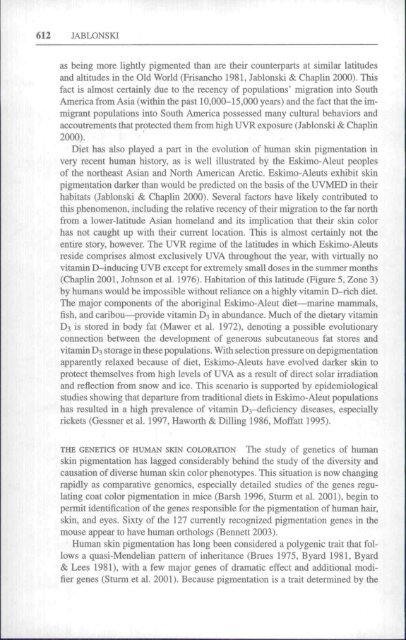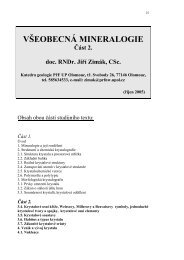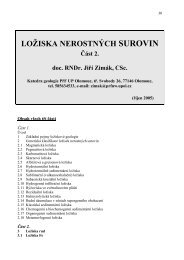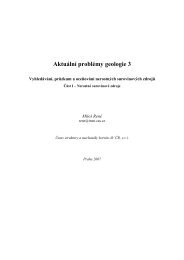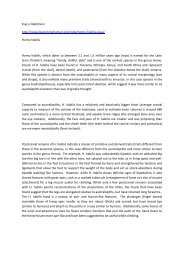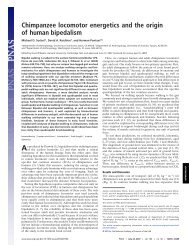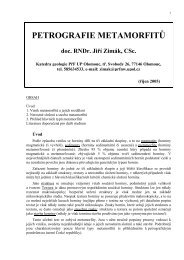THE EVOLUTION OF HUMAN SKIN AND SKIN COLOR Nina G ...
THE EVOLUTION OF HUMAN SKIN AND SKIN COLOR Nina G ...
THE EVOLUTION OF HUMAN SKIN AND SKIN COLOR Nina G ...
You also want an ePaper? Increase the reach of your titles
YUMPU automatically turns print PDFs into web optimized ePapers that Google loves.
612 JABLONSKIas being more lightly pigmented than are their counterparts at similar latitudesand altitudes in the Old World (Frisancho 1981. Jablonski & Chaplin 2000). Thisfact is almost certainly due to the recency of populations' migration into SouthAmerica from Asia (within the past 10,000-15,000 years) and the fact that the immigrantpopulations into South America possessed many cultural behaviors andaccoutrements that protected them from high UVR exposure (Jablonski & Chaplin2000).Diet has also played a part in the evolution of human skin pigmentation invery recent human history, as is well illustrated by the Eskimo-Aleut peoplesof the northeast Asian and North American Arctic. Eskimo-Aleuts exhibit skinpigmentation darker than would be predicted on the basis of the UVMED in theirhabitats (Jablonski & Chaplin 2000). Several factors have likely contributed tothis phenomenon, including the relative recency of their migration to the far northfrom a lower-latitude Asian homeland and its implication that their skin colorhas not caught up with their current location. This is almost certainly not theentire story, however. The UVR regime of the latitudes in which Eskimo-Aleutsreside comprises almost exclusively UVA throughout the year, with virtually novitamin D-inducing UVB except for extremely small doses in the summer months(Chaplin 2001, Johnson et al. 1976). Habitation of this latitude (Figure 5, Zone 3)by humans would be impossible without reliance on a highly vitamin D-rich diet.The major components of the aboriginal Eskimo-Aleut diet—marine mammals,fish, and caribou—provide vitamin D3 in abundance. Much of the dietary vitaminD3 is stored in body fat (Mawer et al. 1972), denoting a possible evolutionaryconnection between the development of generous subcutaneous fat stores andvitamin D3 storage in these populations. With selection pressure on depigmentationapparently relaxed because of diet, Eskimo-Aleuts have evolved darker skin toprotect themselves from high levels of UVA as a result of direct solar irradiationand reflection from snow and ice. This scenario is supported by epidemiologicalstudies showing that departure from traditional diets in Eskimo-Aleut populationshas resulted in a high prevalence of vitamin D^-deficiency diseases, especiallyrickets (Gessner et al. 1997, Haworth & Dilling 1986, Moffatt 1995).<strong>THE</strong> GENETICS <strong>OF</strong> <strong>HUMAN</strong> <strong>SKIN</strong> <strong>COLOR</strong>ATION The Study of genetics of humanskin pigmentation has lagged considerably behind the study of the diversity andcausation of diverse human skin color phenotypes. This situation is now changingrapidly as comparative genomics, especially detailed studies of the genes regulatingcoat color pigmentation in mice (Barsh 1996, Sturm et al. 2001), begin topermit identification of the genes responsible for the pigmentation of human hair,skin, and eyes. Sixty of the 127 currently recognized pigmentation genes in themouse appear to have human orthologs (Bennett 2003).Human skin pigmentation has long been considered a polygenic trait that followsa quasi-Mendeiian pattern of inheritance (Brues 1975, Byard 1981, Byard& Lees 1981), with a few major genes of dramatic effect and additional modifiergenes (Sturm et al. 2001). Because pigmentation is a trait determined by the


